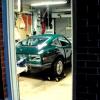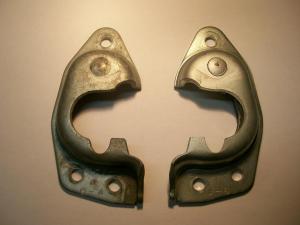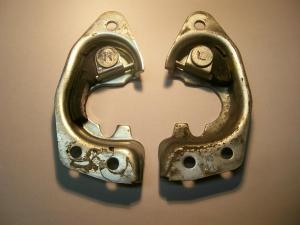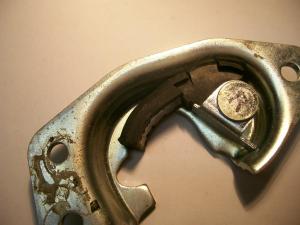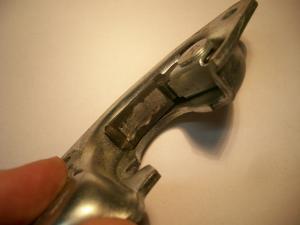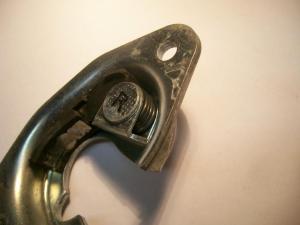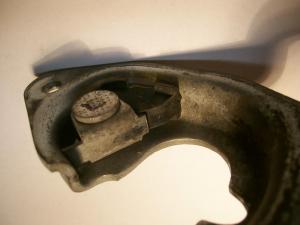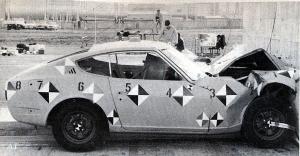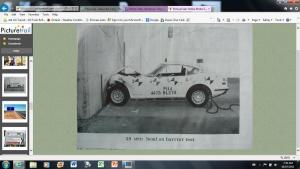Everything posted by Namerow
-
Door Striker Plate Question
Thanks, zCars. Interesting, but worrisome, to learn that the missing 'dangly rubber bit' is typical. If that's the case, then I would guess that most of the Z's on the road are missing this piece on at least the drivers-side door (MFS... Most Frequently Slammed). It would appear that the dangly rubber bit is the part that takes most of the impact when latch meets striker (as testified by the fact that it breaks off on the drivers side, but not on the passenger side). So wouldn't the loss of the main impact-absorbing piece be a bad thing? I guess the only way to tell would be a 'door slam comparison test', using striker plates that do and do not have an intact rubber cushioning block. Not likely to happen, I suppose. BTW, I still don't understand why there's a spring. Are you telling me that you think the rubber block is supposed to pivot on the mounting pin? If that's the case, is the block supposed to pivot out away from the plate frame in the door-open condition and then get pushed back flush against the frame when the lobe on the door latch hits it? Any door latch experts in the audience?
-
Door Striker Plate Question
I happened to be looking at my '70 Z's door striker plates (aka 'door catch') the other day and noticed, for the first time, that they're not as simple in design as I thought. It had always been my impression that they're just one-piece metal stampings. When I turned one of them over, I discovered that this isn't the case at all. They're actually pretty complicated in design and construction, consisting of: Main stamping Cushion Block (rubber molding with a metal insert) Mounting Pin & Spring for Cushion Block Mounting Boss (metal stamping) for Cushion block I'm not really sure how the cushioning block arrangement is supposed to work. Any efforts to make it pivot on its mounting pin have been unsuccessful, so I'm not even sure if it's supposed to move in the first place (but then, why is there a spring? and why does it appear that there's a metal tab on the mounting boss to set a 'rest' position?). Note: In the third picture, I levered the 'leg' of the cushion block away from the striker plate surface to show the amount of flexibility it has (i.e. the leg's displaced position wasn't generated by the cushion block pivoting on its pin). Normally, the 'leg' rests on the inner surface of the striker plate, as shown in picture #2. In addition, I'm not sure whether either of my striker plates has a fully-intact cushion block. As you'll see from the last picture, the cushion block for my left-door striker plate has broken off up near the pivot pin. I'm not even certain that the cushion block on my right-side unit is still its original length. Notice how the rubber has worn off on the 'intact' cushion block to expose the metal underneath. This would be the place where the latching lobe impacts and sits when the door is latched closed. So, two questions: 1. Does anybody have a picture of a NOS striker plate that shows what the cushion block looks like when it's new? 2. Can anyone explain how the cushion block is supposed to work? (i.e. Is it supposed to pivot and, if so, how much? If not, why is there a spring?)
-
Body panels
The swap meet organized by the Ontario Z-Car Club back in October had at least one set of Z doors in v. good condition that did not sell. Hood, I'm not so sure about (they're a little more difficult to haul back and forth to events). Bottom line is that these parts are still out there. I think that if you post a want-to-buy listing on the parts-for-sale section of the larger owners club sites, you'll find what you need pretty quickly -- and probably at a good price, too.
-
240z Inspection Light Source?
Niles Co. - still in business... Niles Co., Ltd. - ProfileNiles has been developing and manufacturing switches and other electronic components for automotive use ever since its establishment in 1954. Born just over a half-century ago in Tokyo’s Ota Ward, Niles has developed into one of the leading automotive electronics component suppliers in the world, with sales, engineering and manufacturing bases in Japan, the US, Europe and Asia. We at Niles are truly grateful for the support and patronage from all of our business partners over the years. Our outstanding reputation for quality and technology have been embraced by auto manufacturers and automotive systems suppliers around the world. We at Niles understand that our customers expect only the best from Niles, and we are poised to meet the challenge. N.I.L.E.S. = Nippon Instrument Light & Electric S___ ? (just a guess) Maybe somewhere at the back of their warehouse, there's an unopened carton of brand-new Z inspection lights!
-
Got to love ZTherapy
I'd like them back now, please.
-
Differential front mount insulator for a 1970 S1 240Z - NLA?
Thanks, Chris.
-
Differential front mount insulator for a 1970 S1 240Z - NLA?
I noticed today that MSA has begin to offer refurbished differential hanger brackets on an exchange basis. In their write-up on these new parts, they discuss applications in relation to solving the differential 'clunk' problem and emphasize that Series 1 owners will need to install the Series 2 differential hanger parts and moustache bar in order to be able to use the Series 2 front insulator (I believe that this is because the arrestor strap won't fit otherwise). This made me curious, so I started to look around some of the commonly-used parts vendors' websites to see if anyone was offering the Nissan Series 1 part (PN 55415-E4102, for reference). A quick look turned up 'not available' at Rock Auto and Chesapeake Nissan. Z-Car Source of Arizona offers only used units, and only on special order. Courtesy Nissan lists the part and a price, but that doesn't mean they have it or can get it (I haven't asked them yet). MSA lists it, but warns that it "...has been discontinued by Nissan or another manufacturer, and we are currently in the process of locating an alternate supplier or having the item reproduced" So: Is a new OE Series 1 diff mount/insulator definitely NLA ? If so, are there any known aftermarket options?
-
REAR MOST EXHAUST MANIFOLD STUD PROBLEM
The failure of the rearmost manifold stud seems to be common to the Z L-Series engines and it's the bane of a lot of Z owners (i.e. welcome to the club). Your ex-Nissan friend's statement that the cause comes from rearward shift of the manifold is interesting -- many have speculated on why this particular stud shears off, but I'm not sure I've ever heard exactly that explanation before. In the end, though, 'why' doesn't really matter. You need a solution. Because I have to deal my the same problem with my '70 (and I'm about the same age as you), let me think out loud for both of us: Note: Everything I say below is premised on the assumption that the stud is sheared off flush with the surface of the head, so that there's nothing left to grip on. Solution #1: Remove the stud using heat and an EZ-out. As noted by Patcon, the intake and exhaust manifolds are going to need to come off. Then you'll need to drill an accurately-centered/directed hole into a small-dia stud and use the smallest-dia ez-out in your toolbox. From my experience, this is a certain recipe for disaster. It's going to be hard to get that hole drilled accurately with the engine/cyl head still in the car. I predict the end result will be an ez-out snapped off inside the stud. Now what do you do? Solution #2: Forget about trying to drill a hyper-accurate hole and forget about using an ez-out, too. Forget about trying to save the old threads. Just drill a reasonably accurate hole into the stud, then keep stepping up the drill bit diameter until you've taken out all the stud material and created a hole in the aluminum head casting suitable for tapping for a next-oversize stud. I believe this is the most common solution, historically. You may want to wait to hear what others have to say about this, though. Solution #3: Remove the head and take it to a competent machine shop. There's an element of trust involved in this approach. You may end up with an oversize stud anyway (see #1, above). Solution #3: Remove the head and try the ez-out strategy, taking advantage of better access to drill an accurate hole and apply directed heat. Good luck with this. I've recently tried to get a snapped-off mounting stud out of a Honda windshield wiper motor casting. The stud has a 6mm thread. The motor/casting was sitting on my bench in a vise, so I had perfect access. I pre-soaked the stud with repeated applications of acetone/ATF for over a week. I applied heat repeatedly for over two minutes. I even tried cold-shock, using an aerosol spray-cold fluid. Result: On my sixth cautious attempt to get the stud to move, my name-brand ez-out snapped off inside the stud. I might have had a better result using an oxy-acetylene torch for heat, but I don't have one (and it probably would have fried the wiper motor wiring anyway). Solution #4: Remove the head and take it to shop that offers 'metal disintegration' services (also known as 'electrical discharge machining' or 'spark erosion'). Good news: You'll get to keep the original threads and stud size. Bad news: According to others, It's going to cost you $200 - $300. Can anyone else confirm? Solution #5: Remove the head and replace it with a used one. Z cylinder heads seem to be dirt-cheap. Of course, you'll need to be sure that the one you get is straight and not damaged (check the cam lobes for good wear patterns). It may need new valve seals (but then, the one on your engine may already need these anyway).BTW, all of the head-removal strategies are going to require ponying up for the cost of a gasket kit. Comments, anyone?
-
Engine pictures
That's a great resource. Lots of time invested by the owner of the site. Now I know where the wire stand for the oil pressure sender unit goes!
-
Safety?
Crash test results for the Z. One by Nissan, pre-production. The other by U.S. government testers. Both, I believe, at 30 mph. In my opinion, the most important thing you should attend to is the condition of the car's seat belts and their mounting points. Forty-year-old seat belts are not a good idea. First, the material characteristics can change over time (exposure to sunlight UV rays and air pollution). Second, the webbing may have become damaged (frayed edges, mini-nicks, etc.). It will be very difficult to find 'new-old-stock' Nissan belts. Most Z owners look to either Wesco Performance or Motor Sports Auto (MSA) for new, replacement belts. These have the additional advantage of providing brand-new retractor mechanisms (unlike the forty-year-old items in most Z's, which are likely not too happy about retracting smoothly). New seat belts are inexpensive insurance against being thrown out of the vehicle or going through the windshield in a crash. They're also important in that they let you and your body 'ride down the impact' by absorbing your forward energy as they stretch under load. You may come out of a crash with some black-and-blue marks, but that's better than the alternative. Of course, new belts aren't much good if any of the mounting points have deteriorated. Unfortunately, that's a problem area with a lot of Z's, since the lower outboard mounting points for the belts is situated in a chronic rust area (that's also difficult to repair properly). Have this inspected by somebody competent.
-
Spindle pin removal tool survey
Having seen the pain that others have gone through for this particular job (Exhibit A: Blue's write-up on the Atlantic Z-Cars site; Exhibit B: Hardway's write-up on this site), I don't think there would be an issue with $80 - $100 for this tool -- if it proves to be effective. The big socket would only add another $10 or so.
-
intake/exhaust studs and bolts?
Puzzle solved (unless that extra '012' stud shows up in another location on the engine!). Or maybe Nissan already knew that the rear stud was going to break on 90% of the L-6 engines they produced and decided to equip each car with a spare .
-
intake/exhaust studs and bolts?
I'm still confused. For the '013' studs, I assume that these are for the outermost holes at the front and rear of the head, each of which also serve to locate an engine sling/hoist plate (this agrees with the fiche/e-fast, which says 2 required). I agree with the count of 6 required for the '014' studs. However, for the '012' studs, I count a total of 6 + 3 = 9 required (fiche/e-fast says 10 required). So, which is correct: 9 x '012' + 2 x '013' ? or, 10 x '012' + 1 x '013' ? Or is it something else?
-
Leather seats recommodations
When installing my new vinyl seat covers (made by Distinctive Industries, bought from Banzai Motorsports), I discovered that the cover for the 'cushion' (bottom) part of the seat is sized specifically for the aftermarket replacement foam. That aftermarket replacement foam bottom piece is molded so that it's about 2 cm taller ('thicker') than the original Nissan foam. This was only an issue for the bottom part of the seat. However, you can't buy the top and bottom foam pieces separately. I was able to get proper fit with my old Nissan foam (which, on my car, was in remarkably good shape) by putting a 1-inch-thick slab of upholstery-shop foam under each molded bottom piece. Nevertheless, for best fit, my experience suggests that new seat covers should be accompanied by new seat foam. I expect that the leather seat covers will also be sized for the aftermarket replacement foam. Maybe somebody who's bought the MSA or Innovative Industries leather covers can comment.
-
1973 Rebuild
The British car restoration magazine, 'Classics Monthly' did a comparison test of several different paint strippers in 2013. They found a significant difference in performance (speed) and ease-of-use (incl. fumes) across the products tested. Also in price. Some of their notes and tips: New UK government environmental regulations forced a change in formulations at some point after 2000. The banished chemical was a solvent called dichloromethane (DCM). After the DCM ban, some of the revised stripper products no longer performed as well as they had previously (meaning that some brands may no longer live up to their reputations, while others may no longer deserve a poor reputation). Not sure whether a similar ban on DCM occurred in the USA.Gels are preferred over liquids because they stick to vertical panelsFor best results, etch the paint surface with a utility knife or single-side razor blade, creating a 1"-spacing crosshatch patternDon't let the stripper get into panel gaps or joins. It's hard to flush out afterwards and can foul up your new paintwork. The recommendation is to tape off fixed-panel edges and all panel seams and gaps before applying the stripper.After application of the stripper, cover the panel surface with cling wrap (aka food wrap or Saran wrap) to keep the stripper from evaporatingThe best product tested worked quickly went through several layers of paint with just one application. A less expensive stripper worked equally well but had to be left overnight to work.The least-effective products worked slowly and require multiple applicationsA few strippers are -- with care -- safe for use on fibreglass, Most, however, aren't.In conclusion, using a poor-quality stripper will result in a lot of unnecessary work. Using a high-quality stripper can be a surprisingly easy process. Pre-etching the paint with a knife helps a lot. The magazine's test winner was a product called 'Rustins Strypit' (www.rustins.co.uk). Sells in various-size containers, from 250ml to 4 litres. Due to transportation safety regulations, I'm not sure whether these kinds of products can be shipped from the UK in small or single lots.
-
Dings on 1972 240z dashboard! Fix or replace whole dashboard?
JAlex: If you decide on the option of replacing, 're-skinning' the dash (Just Dashes) or 'restoring' the dash (filler, followed by truck bedliner spray), the dash has to come out of the car. Your Z will be disabled and undriveable for weeks. Maybe months. Do you really want that? Also: My sense from your other posts is that you're not really a do-it-yourself kind of guy, so be warned than any of these three routes is going to cost you a LOT of ca$h for shop labour. Also, if the shop you choose hasn't got previous experience with a Z dash remove/replace, there's a good chance that they'll screw something else up in the process. If -- for whatever reason -- you choose to re-skin your dash, I expect that you'll need to add several hundred dollars to the Just Dashes price to pay for crating and two-way shipping. Same applies to buying a NOS dash (if you're willing to wait for a good one to show up on eBay), although in that case it will just be the cost for crating and one-way shipping. To summarize: Lots of work, lots of time, lots of co$t$, lots of delay, lots of new risks. Then there's the 'dash cap' option. You can choose between a full-coverage cap and a half-coverage cap. Half caps are easy to put on, but not pleasing to all eyes. Full caps look much better, but are more difficult to install successfully. The work and techniques involved are well-described in other places on this site (use the search tool). Done wrong, the cap will probably not fit well around the gauges and the glovebox opening. Also, the cap may split around the corners if you try to force it into place. There's also the risk of warping the cap if you're over-zealous with the use of the heat gun. Nevertheless, despite all of these installation 'challenges', hundreds of Z's have full dash caps that have been (more or less) successfully installed. Note: There are techniques for getting the speedometer or tach out afterwards (again, well documented elsewhere on this site - again, use the search tool), although there's not a 100% guarantee that those techniques will work for you. Ask yourself, though: How often am I going to need to service the speedometer or the tach? Looking at the puncture mark on your dash -- along with the 3" crack that was already there and apparently wasn't bothering you much before the puncture mark occurred -- I think that the epoxy-and-paint suggestion may not be all that bad a solution. If there is more than just this one crack in your dash (and I'll bet there are), I'm even more inclined to suggest that a spot repair makes sense. If you want to try something a little 'better', Eastwood Tools (www.eastwood.com) offers a leather-and-vinyl repair kit that permits taking a small mold of the texture of undamaged surface and then applying it to the repair compound so that the repaired area blends in with the rest of the surface. That sounds easier said than done, though. You'd probably want to practice with it on some other textured-vinyl surface first, before you commit to trying it on your Z's dash. Remember: If the results of a spot repair don't please you, all of the other options still remain available.
-
Caswell Plating
Steve: What are you using for your bath heaters and temperature controllers?
-
Leather door skins
Chris: Don't forget about Interior Innovations ( www.interior-innovations.com ) in Saginaw, Michigan. They offer full-leather interior panel kits for Z's (in a full range of colours), along with full-leather seat covers. Although door panels aren't listed, they might just get interested in producing them if the probable level of demand catches their attention. JJ
-
Changing gauge Bulbs
I noticed the same problem, but I was fortunate to be able to deal with it while the dash was out of my car. There often seemed to be a lot of 'stiction' between the bulb's locating pins (what you call nibs?) and the plastic socket. Might be a combination of micro-dirt on the plastic and oxidization on the pins. Something I did that really seemed to ease the bulb lock/unlock action was to put a tiny bit of grease on the ramps of the plastic socket (i.e. the surfaces that the pins on the base of the bulb ride on). I used dialectric grease because it was handy at the time. I suppose that any grease would be ok, though, because the ramps are the strictly for mechanical engagement and don't function as electrical connection surfaces. Because you're working on this while your dash is in the car, you'd have to resort to putting a bit of grease on the end of each pin. Not quite as effective as greasing the ramps, but it might work. Just don't over-do it with the grease. And use dialectric grease for sure, because some of it may get onto the electrical contact on the side of the bulb. Try it out first on the bulb that's easiest to reach (usually the one for the clock). If you like the result, you can do the same for all the rest. I can't comment with confidence on your 'yellow bulb' problem because I'm using a different bulb mftr and wattage. Doesn't sound right, though.
-
Inspirational video for those in the middle of their S30 restorations (like me)
Yes, I read the write-up by the engine shop too. Very interesting. Carrillo rods (no surprise) and a billet crank (!). The Aussie builder (located just east of Melbourne, by the way) sounds very knowlegable on the topic of L-series engines. Note the comments about cam wipe patterns and use of Nissan parts. I didn't realize that the 3x2 Mikuni carb setup was that rare and sought-after. Maybe just this particular size? Also, I wonder what kind of power this engine made on the dyno. There was a suggestion that the head had been 'flow-rated for 400 Hp', but there were no figures given anywhere that I could see about the actual outputs achieved at the crank.
-
Inspirational video for those in the middle of their S30 restorations (like me)
1970 Datsun 240Z Gets Hot Engine, Attacks Laguna Seca: Video http://www.motorauthority.com/news/1100300_1970-datsun-240z-gets-hot-engine-attacks-laguna-seca-video
-
Caswell Plating
Nice work, Chris. Pretty labour-intensive, but a great end result. Looks like the acid prep and chromate finishing dips have paid off, so I guess I'm off to the hardware store to buy a few more buckets to add to my growing collection. Your findings about the lack of first-level sensitivity to voltage seem to mirror those of others who've tried this. Anything from 1.5V to 12V seems to be fair game. I need to put together a hi-load potentiometer for my setup so that I can get a bit of current control happening.
-
Seat Re-Assembly After Installing New Seat Covers
Thanks, Jim. That's what I was afraid of. Fortunately, I decided to do one seat at a time so as to learn what to do / what not to do before tackling the second one. Interesting how such a small but important point has never surfaced in any of the the how-to write-ups (not even in Wick Humble's book). Maybe it was just more obvious to everyone else than it was to me!
-
double posted threads
Yup. I just did a new post and that's exactly what happened. Fortunately, I'd seen the double/triple-posts by others, so checked first before being tempted to press the 'Post' button a second time. I suppose that frequent posters know all about this, but newbies probably don't. Not an issue when responding to an existing post. Only when creating a new post. Funny, though. I don't seem to remember this being an issue in the past. Has something 'shifted'?
-
Seat Re-Assembly After Installing New Seat Covers
The topic of installing new seat covers has been covered nicely by Hardway and several others. However, having completed the job on the first of my 70 Z's two seats (Distinctive Industries covers, purchased from Mike at Banzai), I've run into a little conundrum that nobody seems to have ever commented on: For the bottom half of the seat, I installed the seat cover with the sliding seat tracks removed from the seat frame. This seemed only logical, since it provides full access to the underside for purposes of pulling the hem of the cover over the metal tangs (and also for purposes of pulling the listing wire fabric loop down through the slot in the foam and clipping the wire in place. The problem sets in when I try to bolt the track to the frame. The tracks' mounting studs insert into cupped plates welded into the four corners of the tubular frame (the studs, of course, are pressed into the track ends and don't turn). So, now the hex nut needs to get threaded onto the stud (not much access, but do-able)... and tightened. Problem. The raised edges of those cupped plates is making wrench access impossible. I've tried every type of box-end, open-end, and socket wrench that I have in my toolbox. Nothing seems to work. There's not enough space between the underside of the foam and the plane of the hex nuts to get a socket wrench in there. An open end won't work because the cupped edges of the mounting plate gets in the way. It looks like a high-offset box-end might do the job but, as luck would have it none of the five versions of 12mm box-ends in my toolbox have anything more than a minor offset. Even so, what a PITA that would be to tighten all four of those nuts with a non-ratcheting box-end wrench and a swing arc of about 20 degrees. Am I missing something obvious here?




